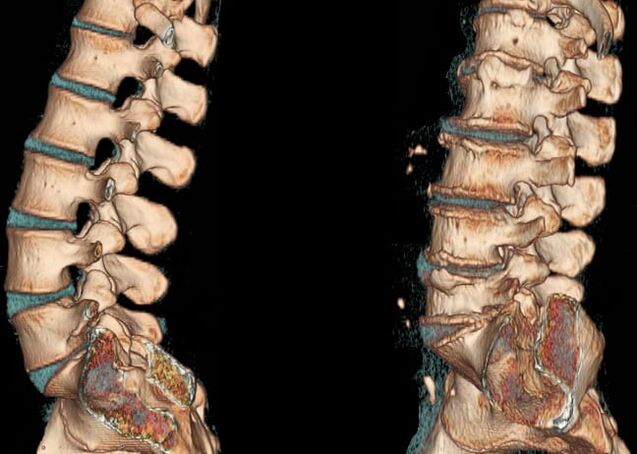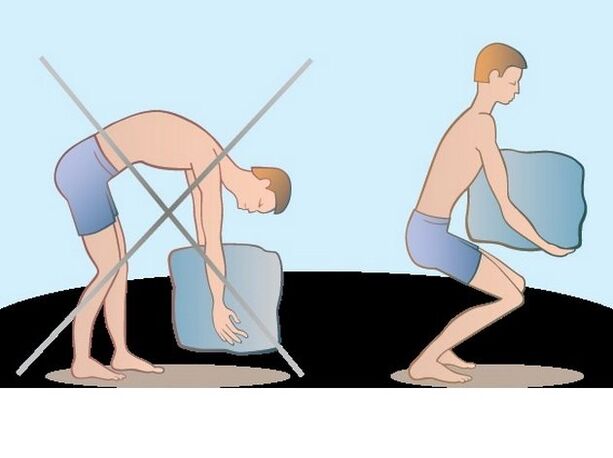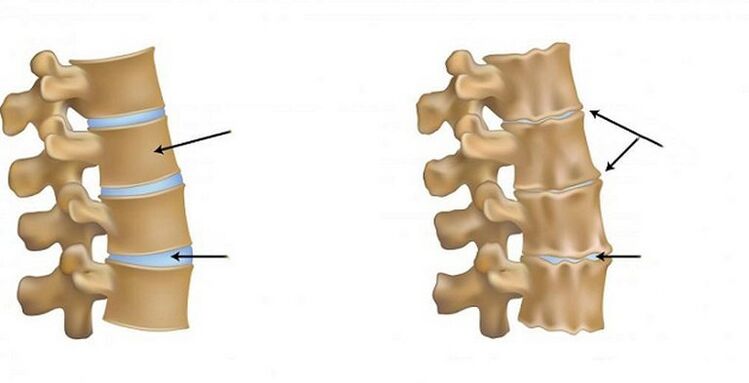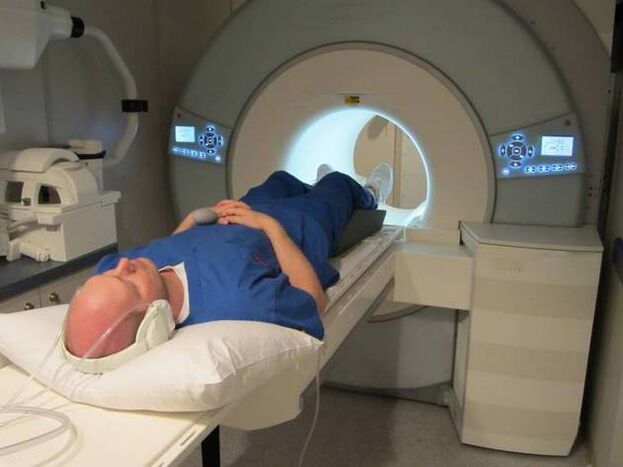
People with osteochondrose of the lumbar spine always avoid sudden movements, carefully leaning and turning to the sides, sit down slowly, get up.So they try to prevent a sharp, breaking pain in the lower back, forcing them to freeze in one body position.Osteochondrosis is also manifested by the crisis, clicks, mobility limit.His treatment is more common more conservative, but with strong disk and vertebral intervention is needed.
What is the osteochondrose of the lumbar spine
Lumbar osteochondrose is a degenerative-dystrophic pathology, which initially affects intervebrelal disks.Due to insufficient nutrient intake, they lose the ability to keep moisture.Regeneration processes slow down, discs become flat, fragile.The distance between neighboring vertebraes decreases, therefore, bone tissue grows to stabilize the lumbar segment thanked osteochondrose.Open forms - bone growth, with displacement, of which the soft tissue of the structure, nerve roots, blood vessels were injured.
Pathology stages
Stage of osteochondrose is the stage of disease development, which characterize certain destructive changes in the discs and bodies of the vertebrae.It was founded using the X -Ray test.In the resulting images, specific signs of destroying the rooky structures are clearly visible.Each phase corresponds to the severity of osteochondrose, set of symptoms.The higher, the heavier disease that is stated in conservative treatment.
| Phase of lumbar osteochondrose | X -Ray characteristics and clinical events |
| First (preclinic) | No signs of osteochondrose on radiographs.Occasionally there is an unpleasant sensation in the lower back after physical effort or long term remain on their feet |
| Second | There is a correction of lorks, less often - scenes of the vertebrae of the body, the deformation of the semi-massive processes.The height of the discs is slightly reduced.A painful sensation often appear, their duration increases |
| Third | Sklerosis subprograms of finishing plates, damage to a large number of semi-massive processes and moderate reduction of disk height.In addition to the pain in the lumbar area, the clinic contains a crisis, motion stiffness |
| Fourth | Harminski processes are discarded outward and backward.There is compensatory growth of bone tissues, forming more osteophytes.Pain occurs when pissing and at rest |
Causes of disease

The causes of osteochondrosis development are often increased charges on lumbar spine.The discs are constantly microtrows, not that time do not return in a timely manner.A significant part is gradually damaged, initiating the deformation of the bone bodies of the vertebrae.Such pathological conditions are also capable of causing the destruction of the lumbar segment:
- Congenital or acquired anomalies - flat feet, scoliosis, kyphosis, deformation of valgus feet, tbs dysplasia;
- System pathologies - rheumatoid arthritis, scleroderma, red lupus;
- endocrine and metabolic diseases - diabetes melitus, hypo- hypertyroidism, obesity;
- Previous injuries - subclusion of vertebrae and their fractures, damage to the spinal cord;
- Circulatory disorders, including against the background of a seated lifestyle.
One of the main causes of osteochondrose is the natural aging of the body.After 50 years, the recovery processes are slowing down, collagen production decreases, the state of the ligaments is deteriorating.
Characteristic signs and symptoms of the disease
In the initial stage of development osteochondrosis does not appear clinically.The person takes the weak pain of lower back for the overvoltage of muscle after the working day and is not advised with the doctor.But the severity of the symptoms slowly increases - soon crumbs with slopes and revolved case, sensitivity disorders and stiffness are associated with pain.
Rook syndrome
This is the name defeat of spinal roots, leading to motor, vegetative and severe disorders.The rotor syndrome is developing with osteochondrome 3-4 severity.The intervertebral hernia is formed at these stages, compressing the roots of the spine.The pathology continues according to the type of Lumbago, Lumbalgia and Lumbar -ilgia.In addition to strong pain, radical syndrome is characterized by the Sensations of the OFBNESS, tingling, crawling goosebumps, reduced or complete absence of sensitivity.
Ischemic syndrome

In the late phases of the lumbar osteochondrose course, it is possible to summarize the hernicly large blood vessels.Calvian authorities stop gaining a sufficient amount of nutrients, leading to violations of their functioning.The cerebral cerebral trophy is also upset, neurological deficiency develops - occasional chromeness, temperature, sensitivity to pain falls.
Vertebra syndrome
As a result of reducing the distance between the neighboring bodies of vertebrae, the growth of bone tissues, the lumbar segments of the vertebrae are gradually deformed.The situation worsens with constant compensatory stress of the rear muscle with their subsequent atrophy.Patholologically changing the gait and holding a person, including irregularly redistribution of cargo.The probability that other parts of the spine and the joints of the leg in a destructive depressive process increases significantly.
The syndrome of pain
At the bottom of the back there is a large spiral nerve that is formed with the sacral roots of the spin.When it is violated by the herniatic protuberance, bone growth, boning muscles, ishys - a typical symptom of lumbar osteochondrose.There is an acute pain that spreads along the nerve nerve to hips, knees, lower legs (lumbar -ilgia).Another specific feature of pathology - lumbago or "shooting" in the lower back after a sharp inclination or turning, hypothermia.
Diagnostic methods

When making diagnosis, radiographic images recorded in two projections are the most informative.To study a more detailed lumbar segment, MRI.The study allows you to assess the state of spinal cord, soft tissues, blood vessels, nervous roots.It is possible to determine the degree of damage to nerve logs using caused potentials, electromopography, electromenographies.Discography is used to target the affected discs.
How is treatment implemented
Exercise all-encompassing access to the therapy for lumbar osteochondrosis.The treatment is focused on removing pain, restoration of the amount of movement, preventing the spread of pathology to healthy disks and vertebrae.
Drug
Using non-atein -infalm ratings, glucocorticosteroids, muscle relaxants allows you to get rid of lower back pain.In therapy, drugs are used to improve blood circulation.Patients must be prescribed by the Vitamins of the Group B, hondroprotectors.
Medical physical education
This is the most efficient and more affordable treatment for osteochondrose.After 1-2 months of daily treatment of physiotherapy exercises, muscles not only the lower back, but all back, improve holding, speed up blood supply into damaged structures on damaged connective tissues.LFK doctors recommend that patients recommend slow smooth agile and torso, shallow squat and lungs.
Massage
Lumbar osteochondrose patients show all types of massages - vacuum, acupuncture, connective, segment.But the most on request is classic.During the session, the massage therapist performs main massage movements: caress, rubbing, interference, vibration.The objectives of the procedure are to remove muscle cramps, improve blood circulation in the affected segment and strengthen skeletal muscles.
Physiotherapy
In an acute and subacute period, patients are prescribed by electrophoresis or ultrafonaphore with glucocorticosteroids, anesthetics, group B vitamins.At the remission phase, laser therapy, magnetotherapy, stress-wave therapy and UHF therapy are often carried out.Ozoceritoling, paraffin applications, hyrodotherapy, mud, radon, watercourse baths were also used.
Surgical intervention
The main indication for surgical intervention is a violation of the spinal cord with a hernic protrusion.During the operation, intervertebral hernia is removed, a spinal channel decompression is made.The most commonly used methods of surgical intervention for lumbar osteochondrosis are microdiscectomy, breakdown or laser reconstruction of the disk, implant installation, ribbon stabilization.
Traditional medicine
After the main therapy, the achievements of a stable remission in treatment, domestic fats, plant teas, compression, oil and rubbing are used.National medications do not affect the cause of osteochondrosis, therefore they are used to remove weak, painful pain, severity in the lower back after hypothermia, sharp changes of time or increased physical activity.
Consequences of lack of treatment
Development of almost all complications of lumbar osteochondrosis cause an intervertebral hernia formed.Discogenic miniopathy is especially dangerous, which does not always show surgical treatment.It manifests it pelvic officers, including defecation disorders, urination.Complications of osteochondroise include syndrome in Roosor - the common cause of acute, piercing pain in the lower back.
Prevention and forecast measures
The forecast is favorable in diagnosis of pathology of 1-2 degrees of severity.It is well deals with conservative treatment well, and in young patients, it is possible to partially renew the tissues of intervertebral disks.With the development of complications, the forecast for a complete recovery is less favorable.
Prevention of osteochondrose The lumbar spine is to control the body weight, exclusion of excess load, timely treatment of endocrine, metabolic diseases.Neurologists and releases recommend visiting the pool, deal with aquarobic, Pilates, Scandinavian walking.



















